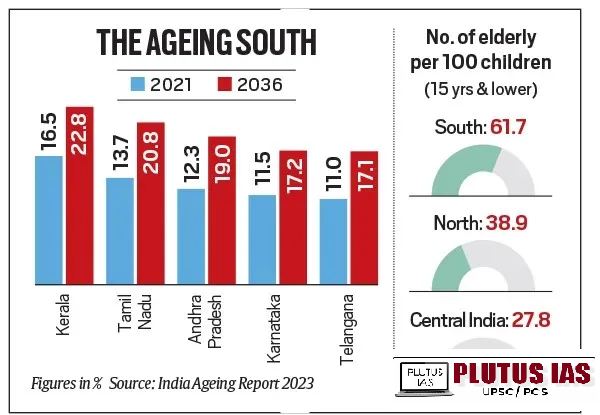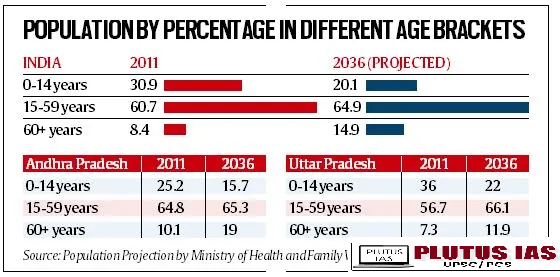26 Oct Demographic Shift: Unpacking Population Decline in the Southern States”
SYLLABUS MAPPING:
GS-2- Social Issue-Demographic Shift: Unpacking Population Decline in the Southern States”
FOR PRELIMS:
What are the primary factors contributing to population decline in southern states?
FOR MAINS:
Evaluate the impact of education and workforce development on reversing population decline in these regions.
Why in the news?
Southern India has witnessed a significant demographic shift as its total fertility rate (TFR) falls below the replacement level. As a result, the chief ministers of Andhra Pradesh and Tamil Nadu, N Chandrababu Naidu and M K Stalin, have publicly expressed concerns about the potential consequences of declining birth rates.
Data on population:
Declining Fertility Rates:
Southern states such as Andhra Pradesh, Tamil Nadu, and Kerala have reached or are approaching replacement-level fertility rates (2.1 children per woman).
Key Milestones:
Andhra Pradesh: Achieved replacement-level fertility by 2004.
Kerala: Reached this level as early as 1988.
These states exhibit significantly lower fertility rates compared to Northern India, resulting in slower population growth.
Ageing Population:
With lower fertility rates and increasing life expectancy, Southern India is experiencing a rapid demographic shift toward an older population.
For example, in Kerala, the proportion of the population aged 60 and over is projected to rise from 13% in 2011 to 23% by 2036.
Andhra Pradesh and Tamil Nadu are witnessing similar trends, leading to a growing elderly demographic.

Population Growth Contribution:
Southern states are projected to contribute only 9% to India’s total population growth from 2011 to 2036.
In contrast, Northern states, particularly Uttar Pradesh and Bihar, are expected to account for a much larger share of the country’s future population growth.
Internal Migration and Workforce:
Due to declining birth rates and a shrinking working-age population, Southern states increasingly rely on internal migration from Northern India to fill labour shortages and sustain economic growth.
This migration helps address workforce gaps in various sectors, particularly in urban areas.
Impact on Political Representation:
The slower population growth in Southern India raises concerns about political representation. With the delimitation of constituencies, Southern states might lose some parliamentary seats.
Conversely, more populous Northern states like Uttar Pradesh and Bihar may gain additional representation, influencing political power dynamics.
Economic and Healthcare Strain:
The rising elderly population in Southern states is expected to increase healthcare expenditures and put additional demands on social security systems.
Policymakers will need to address these challenges to ensure adequate support for an ageing population.
Northern India Population Trends
Higher Fertility Rates:
Northern states like Uttar Pradesh and Bihar continue to have higher fertility rates compared to the South, contributing to significant population growth.
These states are characterized by younger demographics and higher birth rates.
Population Growth Contribution:
Northern states are projected to contribute a substantial portion of India’s population growth, primarily due to their higher fertility rates.
This demographic trend is expected to continue, affecting overall national population dynamics.
Challenges and Opportunities:
Northern states face challenges such as unemployment, poverty, and underdeveloped infrastructure.
However, they also have the potential for economic growth if they can effectively harness their young population.

Reasons for the population growth divergence between North and South India:
1. Effective Implementation of Family Planning Programs: The family planning initiatives launched in the 1970s were more effectively implemented in Southern states. These programs included better access to contraceptives, healthcare services, and community outreach, leading to a significant reduction in fertility rates.
2. Low Total Fertility Rate (TFR) Due to Education: Southern states have achieved higher levels of education, particularly among women. Increased educational attainment correlates with lower fertility rates as educated women are more likely to delay childbirth, pursue careers, and make informed family planning choices.
In contrast, Northern states often have lower education levels, particularly for women, contributing to higher fertility rates.
3. High Levels of Development: Southern states have experienced greater economic development and urbanization, which typically correlates with lower fertility rates. Economic growth provides better access to healthcare, education, and employment, all of which contribute to family planning and smaller family sizes.
Northern states, while developing, still face significant challenges related to poverty and infrastructure that can hinder similar progress.
4. Low Literacy Rates in Northern States: Lower literacy rates in many Northern states, especially among women, result in limited awareness of family planning methods and reproductive health. This lack of knowledge contributes to higher fertility rates and larger family sizes.
5. Historical Factors and British Cultural Influence: The colonial legacy has had lasting impacts on social structures and governance in Northern and Southern India. Southern states benefited from earlier integration into global trade networks and educational initiatives during the British era, which fostered a more progressive social framework.
Some Northern regions faced more significant disruptions and less focus on education and health during colonial rule, affecting their post-independence development trajectories.
6. Societal Norms and Cultural Differences: In Southern India, societal norms tend to support smaller families and prioritize education, especially for girls. These cultural attitudes contribute to the acceptance of family planning and lower fertility rates.
Northern states often exhibit more traditional family structures and societal expectations that encourage larger families. Cultural norms around marriage and childbearing can reinforce higher fertility rates.
Impact of Population Divergence Between North and South India:
1. Delimitation and Political Representation:
Loss of Parliamentary Seats: Slower population growth in Southern states may lead to a reduction in parliamentary seats during delimitation processes. This could diminish their political power relative to Northern states, which are likely to gain representation due to higher population growth.
Policy Focus: With Northern states gaining more seats, national policies may increasingly reflect their interests, potentially sidelining the needs of Southern states.
2. Aging Population:
Increased Healthcare Demand: Southern states are experiencing a rapidly ageing population, leading to higher healthcare costs and increased demand for geriatric services.
Pension and Social Security Strain: A growing elderly demographic in the South will place additional burdens on pension schemes and social security systems, necessitating reforms to address financial sustainability.
Workforce Challenges: An ageing population can result in labour shortages, prompting Southern states to rely more on migrant workers from the North or other regions.
3. Ruralization and Urbanization:
Population Shifts: In Northern states, high population growth may lead to urban sprawl, with rural areas rapidly transforming into urban centres. This can strain infrastructure, services, and resources.
Rural Development Needs: Conversely, Southern states may see rural areas depopulating as younger generations migrate to cities for better opportunities, resulting in challenges for rural development and agricultural sustainability.
4. Economic Implications:
Labour Market Dynamics: Differences in population growth impact the labour market. Southern states may face a shrinking working-age population, while Northern states may have a surplus of labour, affecting wage levels and employment opportunities.
Investment Patterns: Economic investments may shift towards Northern states, driven by higher population growth, creating disparities in development funding and infrastructure.
5. Educational Disparities:
Resource Allocation: As Northern states grow, there may be an increased demand for educational resources, potentially leading to disparities in quality and access.
Youth Unemployment: Northern states may face challenges in providing sufficient job opportunities for their larger youth populations, leading to increased unemployment and potential social unrest.
6. Social and Cultural Changes:
Migration and Cultural Exchange: Increased internal migration from Northern to Southern states can lead to cultural exchanges but may also result in tensions or conflicts over resources and job competition.
Changing Family Structures: Demographic shifts can alter family structures, with smaller families becoming more common in the South and larger families persisting in the North, influencing societal norms and values.
7. Environmental Sustainability:
Resource Strain: Higher population densities in Northern states may lead to greater environmental challenges, such as pollution and resource depletion, requiring robust environmental policies.
Urban Planning Needs: Southern states with ageing populations will need to focus on sustainable urban planning to accommodate both elderly residents and incoming migrants while preserving the quality of life.
Way forward:
1. Skill Development
Vocational Training Programs: Expand access to vocational training in high-demand sectors (e.g., IT, healthcare, construction).
Entrepreneurship Support: Create incubators and provide mentorship for young entrepreneurs to encourage self-employment.
Digital Literacy: Enhance digital skills through community centres and online platforms to prepare the workforce for the tech-driven economy.
2. Infrastructure Development
Transportation: Improve public transportation systems to enhance mobility, making it easier for people to access jobs and education.
Rural Development: Invest in rural infrastructure, including roads, electricity, and internet access, to improve living conditions and economic opportunities.
Urban Planning: Promote sustainable urban development to accommodate growing populations while maintaining quality of life.
3. Social Security
Health Care Access: Strengthen healthcare systems and provide universal health coverage to ensure that all citizens receive necessary medical care.
Pension Schemes: Expand social security schemes, particularly for the elderly and marginalized communities, to provide financial stability.
Family Welfare Programs: Implement targeted family welfare initiatives that focus on reproductive health education and access to contraceptives.
4. Measures to Reduce Fertility Rates
Awareness Campaigns: Launch campaigns to educate communities about family planning and the benefits of smaller families.
Access to Reproductive Health Services: Ensure the availability of contraceptives and reproductive health services, particularly in rural areas.
Incentives for Education: Provide financial incentives for families that prioritize education for girls, promoting the link between education and reduced fertility rates.
5. Community Engagement
Involve Local Leaders: Engage local leaders and influencers to promote social change and community development initiatives.
Participatory Approaches: Encourage community involvement in planning and decision-making processes to ensure programs meet local needs.
6. Policy Support
Strengthen Policies: Develop and enforce policies that support women’s rights, education, and workforce participation.
Monitoring and Evaluation: Implement systems to track the effectiveness of programs and make adjustments as needed based on data and community feedback.
Conclusion:
Download plutus ias current affairs eng med 26th Oct 2024
Prelims Question:
Q. What demographic challenge is Southern India facing due to declining fertility rates?
A. Increased birth rates
B. Ageing population
C. Higher youth population
D. Rural depopulation
Answer: B
Mains Question:
Q.Examine the potential challenges that an ageing population in Southern India poses for social security systems and healthcare infrastructure. What policy measures can be implemented to address these challenges?
(250 words, 15 marks)



No Comments